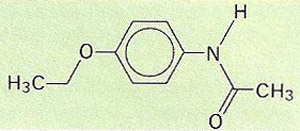paracetamol

The structural formula of paracetamol – (N(4-ethoxyphenol)-ethamide.
Paracetamol is an analgesic drug, i.e., a painkiller. Paracetamol (acetaminophen) is used to treat mild to moderate pain (for example, headache and toothache) and to reduce fever. It has been widely used since 1955.
Unlike aspirin, paracetamol does not cause stomach irritation or bleeding and so is particularly useful as a painkiller for people who suffer from peptic ulcer or who cannot tolerate aspirin. Paracetamol may be used safely to treat children, for whom it is available as a syrup. Paracetamol does not have an anti-inflammatory effect (see inflammation), however, and so is less effective than aspirin as a treatment for injury to soft tissues such as muscles and ligaments.
Possible side-effects of using paracetamol
Taken in normal doses, paracetamol may rarely cause nausea or a rash. An overdose of paracetamol may cause permanent damage to the liver and can be fatal.


